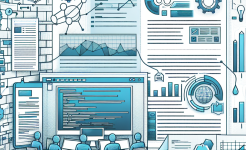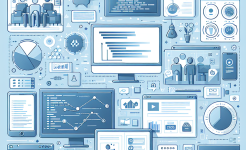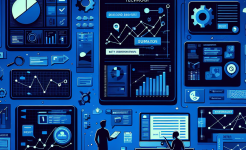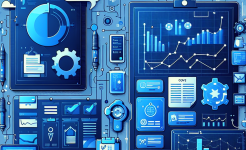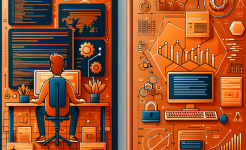Flexibility vs. Rigidity
One of the most significant differences between Agile and traditional development lies in their approach to flexibility. Traditional methodologies, such as Waterfall, follow a linear and sequential process. Each phase of the project, from requirements gathering to testing, must be completed before moving on to the next. This rigidity can be beneficial for projects with well-defined requirements and minimal expected changes. However, it becomes a limitation when dealing with dynamic environments where requirements evolve over time. For instance, in industries like technology or marketing, customer needs and market conditions can shift rapidly, making it challenging to adhere to a fixed plan.
Agile, on the other hand, embraces change and adapts to evolving requirements. The Agile framework is iterative, allowing teams to deliver small, incremental updates to the product. This approach ensures that the project remains aligned with customer needs and market demands. For example, in software development, Agile teams can pivot quickly if new features or functionalities are requested by stakeholders. This flexibility not only enhances customer satisfaction but also reduces the risk of project failure due to outdated or irrelevant deliverables.
Moreover, Agile’s iterative nature fosters continuous improvement. Teams regularly reflect on their processes and make adjustments to improve efficiency and quality. This contrasts sharply with traditional methods, where evaluation typically occurs only at the end of the project, leaving little room for mid-course corrections. By prioritizing flexibility, Agile enables organizations to respond effectively to change, ensuring that the final product meets the evolving needs of its users.
Customer Collaboration vs. Contract Negotiation
Another critical distinction between Agile and traditional development is their approach to customer involvement. Traditional methodologies often treat customer requirements as a fixed contract, with minimal interaction after the initial planning phase. This approach can lead to misunderstandings, misaligned expectations, and ultimately, dissatisfaction. For example, if a customer’s needs change during the project, the rigid structure of traditional methods makes it difficult to incorporate these changes without significant cost and time implications.
Agile, however, places a strong emphasis on customer collaboration. Throughout the project, Agile teams engage with stakeholders to gather feedback, validate assumptions, and ensure that the product aligns with customer expectations. This continuous dialogue helps to build trust and ensures that the final deliverable meets the customer’s needs. For instance, in Agile software development, customers are often involved in sprint reviews, where they can provide input on the latest iteration of the product.
This collaborative approach not only improves customer satisfaction but also enhances the quality of the final product. By involving customers throughout the development process, Agile teams can identify and address issues early, reducing the likelihood of costly rework. In contrast, traditional methods often result in a final product that, while technically sound, may not fully meet the customer’s expectations. Agile’s focus on collaboration ensures that the project remains customer-centric, delivering value at every stage.
Iterative Delivery vs. Big Bang Release
The delivery approach is another area where Agile and traditional development differ significantly. Traditional methodologies typically follow a "big bang" release model, where the entire product is delivered at the end of the project. This approach can be risky, as it leaves little room for early feedback or course correction. If the final product does not meet customer expectations, significant rework may be required, leading to delays and increased costs. For example, in software development, a big bang release can result in a product that is riddled with bugs or lacks key features, frustrating users and damaging the organization’s reputation.
Agile, in contrast, adopts an iterative delivery model. The product is developed in small, incremental releases, each of which delivers a functional piece of the overall solution. This approach allows for early and frequent feedback, enabling teams to make adjustments as needed. For instance, in Agile projects, each sprint results in a potentially shippable product increment, which can be reviewed by stakeholders and users. This iterative process ensures that the product evolves in line with customer needs and expectations.
Moreover, iterative delivery reduces risk by allowing teams to identify and address issues early in the development process. By releasing small, functional increments, Agile teams can validate assumptions, test hypotheses, and gather valuable insights that inform subsequent iterations. This contrasts with traditional methods, where issues may only become apparent at the end of the project, when they are more difficult and costly to resolve. Agile’s iterative delivery model ensures that the final product is not only high-quality but also closely aligned with customer needs.
Team Structure and Roles
The structure and roles within Agile and traditional development teams also differ significantly. Traditional methodologies often rely on a hierarchical structure, with clearly defined roles and responsibilities. For example, in a Waterfall project, the project manager is typically responsible for planning, executing, and closing the project, while team members have specialized roles, such as developers, testers, and designers. This structure can lead to silos, where communication between team members is limited, and collaboration is minimal.
Agile, however, promotes a more collaborative and cross-functional team structure. Agile teams are typically self-organizing, with members taking on multiple roles and responsibilities. For instance, in a Scrum team, there is no traditional project manager; instead, the team is guided by a Scrum Master, who facilitates the process and removes obstacles. Team members work together closely, sharing knowledge and skills to achieve the project goals. This collaborative approach fosters creativity, innovation, and a sense of ownership among team members.
Additionally, Agile teams are often cross-functional, meaning that they include members with a variety of skills and expertise. This allows the team to handle all aspects of the project, from development to testing to deployment, without relying on external resources. In contrast, traditional teams may require specialized personnel for each phase of the project, leading to delays and inefficiencies. By promoting a collaborative and cross-functional team structure, Agile enhances communication, reduces bottlenecks, and improves overall project efficiency.
Documentation vs. Working Software
The emphasis on documentation is another area where Agile and traditional development methodologies differ. Traditional methods, such as Waterfall, place a strong emphasis on comprehensive documentation. Each phase of the project requires detailed documentation, including requirements specifications, design documents, and test plans. This focus on documentation can be beneficial for projects that require strict regulatory compliance or where extensive documentation is necessary for future maintenance. However, it can also be time-consuming and resource-intensive, potentially delaying the delivery of the final product.

Agile, on the other hand, prioritizes working software over comprehensive documentation. While documentation is still important in Agile projects, it is kept to a minimum, with the focus on delivering functional, high-quality software. For example, in Agile software development, user stories and acceptance criteria are used to define requirements, but these are often brief and to the point. The emphasis is on producing a working product that can be tested and validated by stakeholders, rather than on creating extensive documentation.
This focus on working software allows Agile teams to deliver value to customers more quickly. By prioritizing functionality over documentation, Agile ensures that the product is developed in a way that meets customer needs and can be adjusted as those needs evolve. This contrasts with traditional methods, where the focus on documentation can lead to delays and a final product that, while well-documented, may not fully meet customer expectations. Agile’s emphasis on working software ensures that the project remains focused on delivering value, rather than on producing paperwork.
Risk Management
Risk management is another critical area where Agile and traditional development methodologies differ. Traditional methods often rely on extensive upfront planning to identify and mitigate risks. This approach can be effective for projects with well-defined requirements and minimal uncertainty. However, it can also be inflexible, making it difficult to respond to new risks that emerge during the project. For example, in a Waterfall project, if a new risk is identified after the planning phase, it may be challenging to address without significant cost and time implications.
Agile, in contrast, adopts a more proactive approach to risk management. By delivering small, incremental updates, Agile teams can identify and address risks early in the development process. For instance, in Agile software development, each sprint provides an opportunity to test assumptions, validate hypotheses, and gather feedback, allowing the team to adjust the project plan as needed. This iterative approach reduces the likelihood of major risks going unnoticed until late in the project, when they are more difficult and costly to resolve.
Moreover, Agile’s focus on collaboration and communication enhances risk management. By involving stakeholders throughout the project, Agile teams can identify potential risks early and take steps to mitigate them. This contrasts with traditional methods, where risks may only be identified during the planning phase, leaving little room for adjustment as the project progresses. Agile’s proactive approach to risk management ensures that the project remains on track and that potential issues are addressed before they become major problems.
Continuous Improvement
Finally, Agile and traditional development methodologies differ in their approach to continuous improvement. Traditional methods often rely on a "set it and forget it" mentality, where processes are defined at the beginning of the project and followed throughout. While this approach can provide consistency, it can also lead to stagnation, as there is little opportunity for learning and improvement. For example, in a Waterfall project, the team may follow the same processes and practices for each phase, without reflecting on what worked well and what could be improved.
Agile, however, places a strong emphasis on continuous improvement. Agile teams regularly reflect on their processes and practices, identifying areas for improvement and making adjustments as needed. For instance, in Scrum, the team holds a retrospective at the end of each sprint to discuss what went well, what didn’t, and how they can improve. This focus on continuous improvement ensures that the team is always learning and evolving, leading to higher levels of efficiency and quality.
Moreover, Agile’s iterative nature facilitates continuous improvement by providing regular opportunities for feedback and reflection. By delivering small, incremental updates, Agile teams can test new ideas, gather feedback, and make adjustments as needed. This contrasts with traditional methods, where the focus is on delivering a final product, with little opportunity for learning and improvement along the way. Agile’s emphasis on continuous improvement ensures that the team is always striving to deliver better results, leading to higher levels of customer satisfaction and project success.
In conclusion, Agile and traditional development methodologies represent two fundamentally different approaches to project management and software delivery. While traditional methods offer structure and predictability, Agile provides flexibility, collaboration, and a focus on delivering value. By understanding the key differences between these two methodologies, organizations can choose the approach that best aligns with their project goals, team dynamics, and customer needs. Whether opting for the rigidity of traditional methods or the adaptability of Agile, the key to success lies in selecting the right approach for the right project.
FAQ
1.Can Agile and traditional development methodologies be used together?
While Agile and traditional development methodologies are fundamentally different, some organizations choose to blend elements of both approaches in a hybrid model. For example, a project might use Waterfall for the initial planning and requirements gathering phases, then switch to Agile for development and testing. However, this approach requires careful planning and coordination to ensure that the benefits of both methodologies are realized without creating confusion or inefficiencies.
2.Is Agile suitable for all types of projects?
Agile is particularly well-suited for projects with evolving requirements, high levels of uncertainty, and a need for frequent customer feedback. However, it may not be the best fit for projects with well-defined requirements, strict regulatory constraints, or where a high degree of documentation is required. In such cases, traditional methodologies like Waterfall may be more appropriate.
3.How do I decide which methodology to use for my project?
The choice between Agile and traditional development methodologies depends on several factors, including the nature of the project, the level of uncertainty, the need for flexibility, and the preferences
ARTICLE TITLE :7 major differences between agile development and traditional development ,AUTHOR :ITpmlib


